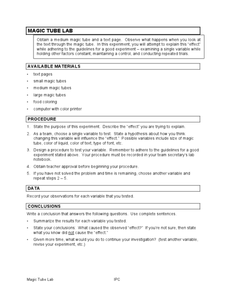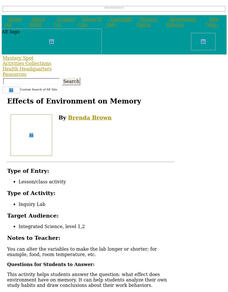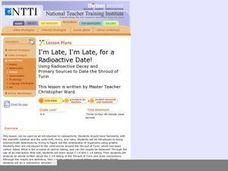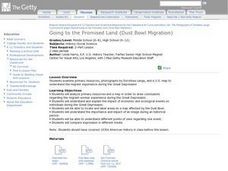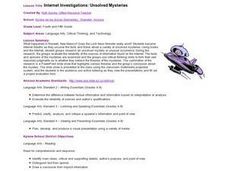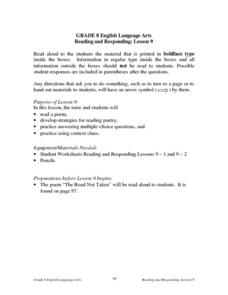Curated OER
The Nature of Science
In this nature of science activity, students identify four statements as "pure" or "applied" science and they read a short story about an experiment performed by a boy. They identify various components of the experiment including the...
Curated OER
Magic Tube Lab
In this scientific investigation learning exercise, students use "magic tubes" to make observations, hypothesize, study variables in experiments, write procedures, and draw conclusions.
Curated OER
How Oceans Affect Climate
Learners draw conclusions about how the ocean affects temperature. In this weather lesson, students use the Internet to gather data to help them come to a conclusion about how the climate in a certain region is directly affected by the...
Curated OER
Logic and Proof Writing
Students define inductive and deductive reasoning and write two column proofs. In this geometry instructional activity, students analyze arguments and draw conclusion. They define steps necessary to arrive at the correct answer when...
Curated OER
Pick's Theorem
Students investigate polygons and their lattice. In this calculus lesson, students record data using different methods. They analyze their data and draw conclusions based on the relationship between the area and the interior lattice.
Curated OER
Effects of Environment on Memory
Students explore the effect that environment has on memory. They analyze their own study habits and draw conclusions about their work behaviors. Baseline capacity is established for the subjects' ability to memorize an increasing series...
Curated OER
Comic Renditions
Students explore the intersection between popular and high art by recreating comic strips in various artistic styles and then famous works of art as comics. Through this exploration, students come to conclusions about what art is and...
Curated OER
I'm Late, I'm Late, for a Radioactive Date!
Through the use of an interactive Web site, students explore C-14 and C-14 dating. Then students analyze an article written about the C-14 dating of the Shroud of Turin and draw conclusions.
Curated OER
Global Warming Statistics
Students research real-time and historic temperature data of U.S. and world locations, and analyze the data using mean, median, and mode averages. They graph the data and draw conclusions by analyzing the data. A spreadsheet is used to...
Curated OER
Going to the Promised Land
Students analyze primary resources and map in order to draw conclusions regarding the migrant-worker experience during the Great Depression. They explain and explain the impact of economic and ecological events on individuals.
Curated OER
A Dream Of Classic Perfection
Students examine primary sources in order to draw conclusions about the influence of Greek classical art and philosophy on the French Revolution. They compare the goals of the French Revolution to those of Neoclassical artists.
Curated OER
Ink Analysis and Thin Layer Chromatography
Students explain the process of TLC. They identify at least three components of ink. They analyze data and make conclusions based on laboratory observations.
Curated OER
Plate Tectonics
Students research separate elements of the theory of Plate Tectonics, then share that information with each other, drawing conclusions from the culminated information.
Curated OER
HEART THROBS
Learners predict what might happen to their pulse rates after physical exertion and then make conclusions about the effects of physical activity on pulse rates.
Curated OER
Internet Investigations: Unsolved Mysteries
Students conduct Internet research to investigate the facts and fiction of various unsolved mysteries. They examine the facts and opinions of the mysteries, and create a Powerpoint slide show to present the theories and the group's...
Curated OER
Egypt's Greatest Leaders
Students study about seven of Egypt's most famous pharaohs. They discuss leadership styles and draw conclusions about the success of each of these pharaohs. They, in groups, create a project about a pharaoh they studied.
Curated OER
What Plants Need in Order to Survive and Grow: Light
Students conduct an experiment to evaluate whether plants need light to survive and grow. They observe and gather data about plant responses to different growth regimes, analyze the data, and make conclusions about basic plant needs.
Curated OER
The Blue Bottle: An Example of Teacher-Guided Inquiry
Learners observe a demonstration in which a bottle containing a colorless solution is mixed, turns blue, then becomes colorless again. They record observations, form and discuss hypotheses, and draw a conclusion based on the evidence.
Curated OER
Environment: Wild Wind Direction
Students examine the different types of wind patterns. Using common materials, they construct weather vanes to measure and record wind direction over a two-week period. After analyzing the data, they draw conclusions about the...
Curated OER
Analysis of Atmospheric Conditions for a High Mountain Retreat
Students examine the relationship between altitude, atmospheric pressure, temperature and humidity at a particular location. They practice science and math in real world applications. They write reports detailing their scientific...
Curated OER
Letting Off Steam
Students examine the concept of transpiration. They work together to complete an experiment in which they see water loss in plants. They record their observations and discuss their conclusions.
Curated OER
The Demographics of Immigration: Using United States Census Data
Learners work together to analyze United States Census data on immigration. They compare and contrast the data and determine how immigration numbers have changed over time. They calculate percentages and make their own conclusions...
Curated OER
Reading and Responding -- Lesson 9
Fourth graders work independently or in a small group with a tutor or teacher to (1) read a nonfictional selection, (2) practice drawing conclusions, (3) identify main ideas, and (4) practice responding to cause and effect questions.
Curated OER
Data Analysis, Probability, and Discrete Mathematics
Fourth graders analyze the data in a bar graph, pictograph, line graph, and a chart/table and draw conclusions based on the data. They discuss each type of graph, write questions for each graph, and analyze the data as a class.
Other popular searches
- Drawing Conclusions
- Drawing Conclusions Reading
- Draw Conclusions
- Writing Conclusions
- Conclusion Sentences
- "Drawing Conclusions
- Inference and Conclusions
- Drawing Conclusion Stories
- And Conclusions
- Writing a Conclusion
- Nonfiction Draw Conclusions
- Conclusion Paragraph



